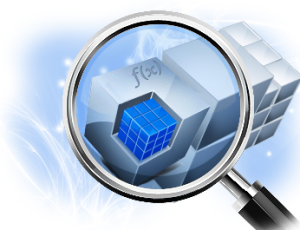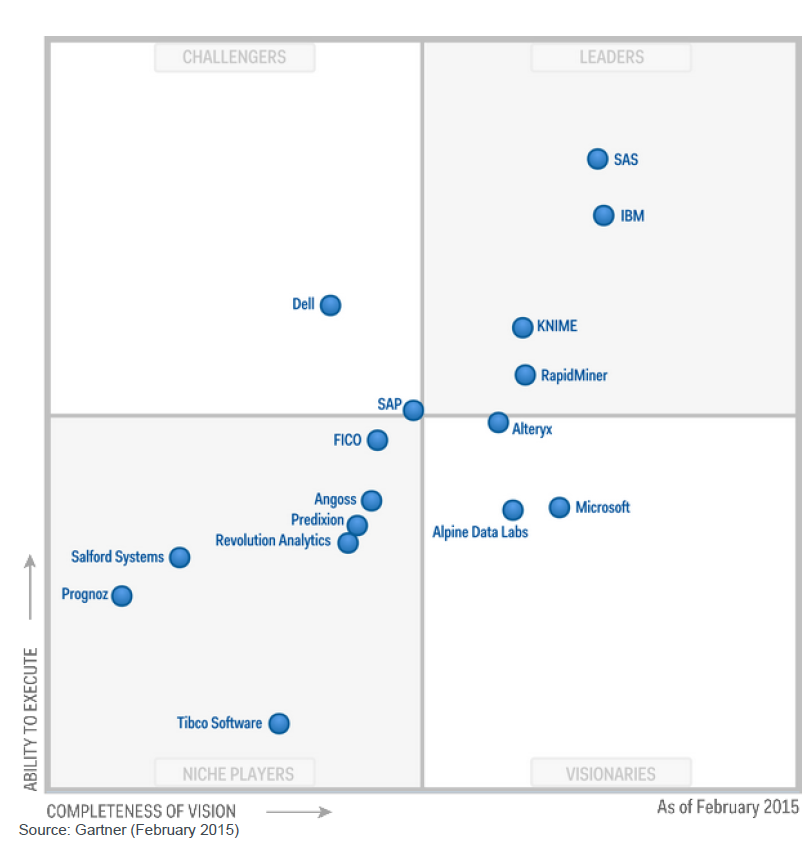
Rating the Advanced Analytics Vendors

There are several ways you can go about obtaining the advanced analytic capabilities needed to extract insights from large amounts of data. You can outsource the whole thing to a services firm, you can buy pre-built applications for a specific industry, or you can buy tools that will let you build what you need. Last week, Gartner rated the top 16 such build-it-yourself tools in the advanced analytics category.
The “Magic Quadrant for Advanced Analytics Platforms” that Gartner delivered last week is the second such report, and follows the analyst firm’s decision in 2014 to separate out regular analytic tools from more sophisticated products. These so-called “advanced analytics” tools use more powerful techniques to tease insights out of big data sets in ways that standard query and reporting tools can never equal.
For each of the 16 tools included in the report, Gartner consulted at least 15 customers to see how the tools worked across 10 different sub-categories, including: data access, filtering and manipulation; data exploration and visualization; predictive analytics; forecasting; optimization;simulation; delivery, integration, and deployment; platform and project management; performance and scalability; and user experience.
SAS and IBM were, once again, the leaders of the pack. Nobody else really comes close to delivering the sorts of advanced analytic capabilities that these two industry giants have delivered, except perhaps the open source R language. Joining SAS and IBM in the Leader’s Quadrant for the second straight year were KNIME and Rapid Miner, which continue to deliver good value to their customers.
Leader’s Quadrant
Gartner hailed SAS‘s extensive product stack, the high levels of performance, scalability, and reliability of the platform, as well as its high customer loyalty and good training programs. The high cost of the software, complex licensing, and steep learning curve were concerns, as was overall value of the software.
IBM lost a bit of ground in Gartner’s eyes, although the firm commended Big Blue’s commitment to this market. Strengths include a large user base, a well-understood product base, and a strong vision (Gartner likes SPSS in the cloud and Watson Analytics). The list of cautions is extensive, however, and includes things like a complex product stack, complex pricing schemes, and lower than average level of customer satisfaction.
KNIME, a Swiss company whose name stands for “Konstanz Information Miner,” moved up a hair in the “ability to execute” axis, but fell a bit in the “completeness of vision” category compared to last year. Gartner likes KNIME’s openness, its active user community, and its high level of overall satisfaction. However, its limited visibility outside core markets, its support, and its UI are listed as concerns.
Rapid Miner also moved around a tad in the “Leaders” quadrant compared to last year, but is still well ranked. Strenghts include bredth of functionality, ease of use, and a new leadership team. Cons for the company (which moved its headquarters to Massachusetts last year) include limited visibility outside core markets, dropping customer satisfaction, and poor training and documentation (growing pains perhaps, Gartner says).
Visionaries Quadrant
In the “Visionaries” quadrant, Alteryx moved up considerably along the “ability to execute” axis and is now on the cusp of breaking into the “Leaders” quadrant. Gartner hailed the company’s ability to work with R and Spark, an easy-to-learn UI, and its new project-oriented sales model. Some customers were put off by Alteryx’s licensing terms, Gartner says, and the lack of visualization capabilities (which Alteryx customer often get through Tableau or Qlik).
Moving into the “Visionaries” quadrant for the first time is Alpine Data Labs, which builds analytics that often run in Hadoop or other data warehousing environments. Gartner liked Alpine’s solid breadth of functionality, its commitment to the cloud, and for incorporating customer feedback into the product. Weaknesses include depth of functionality, visibility in the market, and slow adoption of its Chorus offering.
Microsoft also made the leap into the “Visionaries” quadrant, largely on the back of Azure Machine Learning, which combines ETL, presentation, and R integration into one cloud-based bundle. However, AML was still in beta when Gartner wrote this report, so while it shows promise, it’s unproven. The SQL Server Analysis Services (SSAS) product embedded into SQL Server is a low scorer on Gartner’s table.
Challengers Quadrant
Dell is a new addition to the Magic Quadrant, and inherits the position in the “Challengers” quadrant that was formerly occupied by StatSoft, which Dell acquired in 2014. StatSoft’s Statistica product was well-regarded by users, and Gartner expects Dell to use its larger resources to help that product grow. However, Statistica’s UI has begun to look old, Gartner says, and pricing is also a concern, along with interaction between customers and Dell.
SAP retained its position in the “Challengers” quadrant, but just barely. Gartner is intrigued by what SAP is doing with its KXEN InfiniteInsight product, which will form the basis for a new SAP Predictive Analytics product. Customers are concerned over the roadmap, however, and while HANA is not required to use the KXEN stuff, the dearth of HANA skills is a concern.
Niche Players
Revolution Analytics, which Microsoft just acquired (also before Gartner analysts finished the report) slipped back from the “Visionaries” quadrant into the “Niche Players” quadrant. Gartner is impressed with the company’s ability to scale and support R. But the company was marked down for the high level of technical ability to work with the program, as well as the growth of Python, which is challenging R for supremacy as the data scientist’s language of choice.
FICO, which was on the cup of entering the “Challengers” quadrant last year, fell back firmly into the “Niche Players” category; its acquisition of another “Niche Player,” InfoCentricity, may have had something to do with it.
Several other analytic software vendors debuted on the quadrant for the first time in the “Niche Players” category, including Predixion, Prognoz, Salford Systems, and Tibco Software. Several other vendors were dropped from the report, including Actuate (insufficient references); Megaputer (insufficient references); StatSoft (acquired by Dell), InfoCentricity (acquired by FICO) and Oracle (advanced analytics offering is no longer a stand-alone product).
Related Items:
SAS and IBM King of Analytics Hill, But for How Long?
Hadoop and NoSQL Now Data Warehouse-Worthy: Gartner































